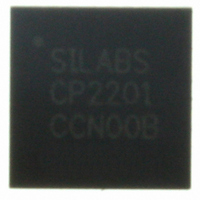CP2201-GM Silicon Laboratories Inc, CP2201-GM Datasheet - Page 58

CP2201-GM
Manufacturer Part Number
CP2201-GM
Description
IC ETH CTRLR SNGL-CHIP 28QFN
Manufacturer
Silicon Laboratories Inc
Specifications of CP2201-GM
Package / Case
48-TQFP, 48-VQFP
Controller Type
Ethernet Controller, MAC/10Base-T
Interface
Parallel/Serial
Voltage - Supply
3.1 V ~ 3.6 V
Current - Supply
75mA
Operating Temperature
-40°C ~ 85°C
Mounting Type
Surface Mount
Ethernet Connection Type
1000BASE-T or 100BASE-T or 10BASE-T
Minimum Operating Temperature
- 40 C
Mounting Style
SMD/SMT
Product
Ethernet Controllers
Standard Supported
IEEE 802.3
Data Rate
10 Mbps or 100 Mbps or 1000 Mbps
Maximum Operating Temperature
+ 85 C
No. Of Ports
1
Ethernet Type
IEEE 802.3
Interface Type
Parallel
Supply Current
60mA
Supply Voltage Range
3.1V To 3.6V
Operating Temperature Range
-40°C To +85°C
Rohs Compliant
Yes
Lead Free Status / RoHS Status
Lead free / RoHS Compliant
For Use With
336-1326 - KIT REF DESIGN PWR OVER ETHERNET336-1316 - KIT EVAL FOR CP2201 ETH CTRLR
Lead Free Status / Rohs Status
Lead free / RoHS Compliant
Other names
336-1313
Available stocks
Company
Part Number
Manufacturer
Quantity
Price
Company:
Part Number:
CP2201-GM
Manufacturer:
SiliconL
Quantity:
48
Part Number:
CP2201-GMR
Manufacturer:
SILICON LABS/芯科
Quantity:
20 000
CP2200/1
12. Receive Interface
12.1. Overview
The CP2200/1 has a 4k circular receive FIFO buffer and an 8 entry translation look-aside buffer (TLB) capable of
storing up to 8 packets at a time. Each TLB entry holds the starting address, length, and other information about a
single received packet. Once a packet is received, the host microcontroller is notified using the interrupt request
pin. The host microcontroller may then copy the contents of the packet to its local memory through the host
interface or skip the packet by writing ‘1’ to RXSKIP (RXCN.1). Skipped packets remain in memory but will be
overwritten as new packets arrive.
The receive interface has an advanced receive filter and hash table to prevent unwanted packets from reaching the
receive buffer. For all packet types not supported by the receive filter, the CP2200/1 allows the host microcontroller
complete random access to the receive buffer. The host microcontroller can check specific bytes in the packet to
determine whether or not to copy the packet.
.
12.2. Reading a Packet Using the Autoread Interface
Once reset initialization is complete (Section 6.2 on page 18) and the receive buffer, filter, and hash table (Section
12.4) are initialized, the CP2200/1 is ready to receive Ethernet packets. After receiving notification of a new packet,
the following procedure can be used to read the packet:
12.3. Timing and Buffer Overflow Considerations
For 10 Base-T Ethernet, a minimum-sized packet of 64 bytes is received in 51.2 us. The maximum number of
packets that can be held by the receive buffer is eight. To ensure that pointer corruption does not occur, software
should disable packet reception (RXINH = 1) after the seventh packet has arrived in the receive buffer. If the ability
to service the packet received interrupt is longer than 51.2us, then software should use the random access method
to retrieve data from the receive buffer. The random access method described in Section 7.1 on page 23.
58
Autoread Interface:
Current Packet:
Host Interface Registers
Step 1: Read RXVALID (CPINFOH.7) and RXOK (CPINFOL.7) to check if the current packet was received
Step 2: If RXVALID or RXOK is 0, or to skip the packet, write a ‘1’ to RXSKIP (RXCN.1).
Step 3: Read the entire packet, one byte at a time, by reading RXAUTORD.
Step 4: If the entire packet was read, write a ‘1’ to RXCLRV (RXCN.2).
Autoread Data Register
Packet Skip Bit
Packet Address
Packet Length
Packet Information
correctly. The host processor may optionally use the packet starting address CPADDR to read
specific bytes in the packet and determine whether to copy or skip the current packet. The random
access method described in Section 7.1 on page 23 can be used to access the buffer.
If RXVALID and RXOK are 1, read the length of the current packet from CPLENH:CPLENL.
If there are any unread bytes remaining in the current buffer, write a ‘1’ to RXSKIP (RXCN.1).
Figure 17. Receive Interface Block Diagram
8-entry TLB
Receive
Rev. 1.0
Buffer
4 KB
with
Receive Filter and
Programmable
Hash Table












